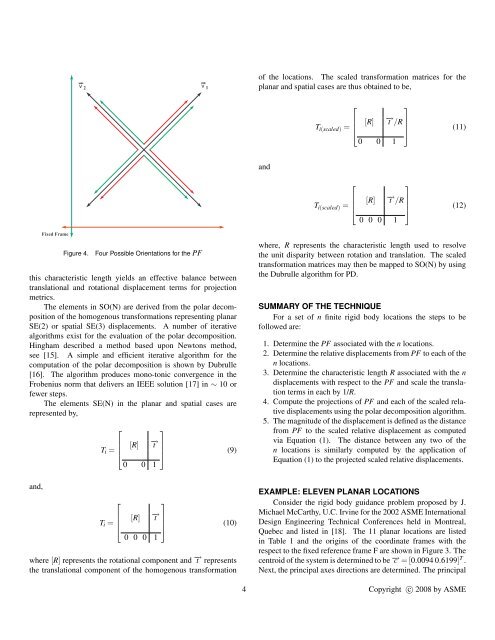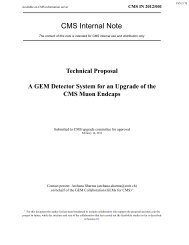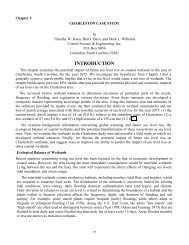A Displacement Metric for Finite Sets of Rigid Body Displacements
A Displacement Metric for Finite Sets of Rigid Body Displacements
A Displacement Metric for Finite Sets of Rigid Body Displacements
You also want an ePaper? Increase the reach of your titles
YUMPU automatically turns print PDFs into web optimized ePapers that Google loves.
Fixed Frame<br />
v 2<br />
Figure 4. Four Possible Orientations <strong>for</strong> the PF<br />
this characteristic length yields an effective balance between<br />
translational and rotational displacement terms <strong>for</strong> projection<br />
metrics.<br />
The elements in SO(N) are derived from the polar decomposition<br />
<strong>of</strong> the homogenous trans<strong>for</strong>mations representing planar<br />
SE(2) or spatial SE(3) displacements. A number <strong>of</strong> iterative<br />
algorithms exist <strong>for</strong> the evaluation <strong>of</strong> the polar decomposition.<br />
Hingham described a method based upon Newtons method,<br />
see [15]. A simple and efficient iterative algorithm <strong>for</strong> the<br />
computation <strong>of</strong> the polar decomposition is shown by Dubrulle<br />
[16]. The algorithm produces mono-tonic convergence in the<br />
Frobenius norm that delivers an IEEE solution [17] in ∼ 10 or<br />
fewer steps.<br />
The elements SE(N) in the planar and spatial cases are<br />
represented by,<br />
and,<br />
Ti =<br />
Ti =<br />
⎡<br />
⎤<br />
⎢<br />
⎣<br />
[R] −→ t ⎥<br />
⎦<br />
0 0 1<br />
⎡<br />
⎤<br />
⎢<br />
⎣<br />
[R] −→ t ⎥<br />
⎦<br />
0 0 0 1<br />
v 1<br />
(9)<br />
(10)<br />
where [R] represents the rotational component and −→ t represents<br />
the translational component <strong>of</strong> the homogenous trans<strong>for</strong>mation<br />
<strong>of</strong> the locations. The scaled trans<strong>for</strong>mation matrices <strong>for</strong> the<br />
planar and spatial cases are thus obtained to be,<br />
and<br />
⎡<br />
⎤<br />
⎢<br />
Ti(scaled) = ⎢<br />
⎣<br />
[R] −→ t /R ⎥<br />
⎦<br />
0 0 1<br />
⎡<br />
⎤<br />
⎢<br />
Ti(scaled) = ⎢<br />
⎣<br />
[R] −→ t /R ⎥<br />
⎦<br />
0 0 0 1<br />
(11)<br />
(12)<br />
where, R represents the characteristic length used to resolve<br />
the unit disparity between rotation and translation. The scaled<br />
trans<strong>for</strong>mation matrices may then be mapped to SO(N) by using<br />
the Dubrulle algorithm <strong>for</strong> PD.<br />
SUMMARY OF THE TECHNIQUE<br />
For a set <strong>of</strong> n finite rigid body locations the steps to be<br />
followed are:<br />
1. Determine the PF associated with the n locations.<br />
2. Determine the relative displacements from PF to each <strong>of</strong> the<br />
n locations.<br />
3. Determine the characteristic length R associated with the n<br />
displacements with respect to the PF and scale the translation<br />
terms in each by 1/R.<br />
4. Compute the projections <strong>of</strong> PF and each <strong>of</strong> the scaled relative<br />
displacements using the polar decomposition algorithm.<br />
5. The magnitude <strong>of</strong> the displacement is defined as the distance<br />
from PF to the scaled relative displacement as computed<br />
via Equation (1). The distance between any two <strong>of</strong> the<br />
n locations is similarly computed by the application <strong>of</strong><br />
Equation (1) to the projected scaled relative displacements.<br />
EXAMPLE: ELEVEN PLANAR LOCATIONS<br />
Consider the rigid body guidance problem proposed by J.<br />
Michael McCarthy, U.C. Irvine <strong>for</strong> the 2002 ASME International<br />
Design Engineering Technical Conferences held in Montreal,<br />
Quebec and listed in [18]. The 11 planar locations are listed<br />
in Table 1 and the origins <strong>of</strong> the coordinate frames with the<br />
respect to the fixed reference frame F are shown in Figure 3. The<br />
centroid <strong>of</strong> the system is determined to be −→ c = [0.0094 0.6199] T .<br />
Next, the principal axes directions are determined. The principal<br />
4 Copyright c○ 2008 by ASME
















